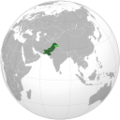Difference between revisions of "Pakistan Energy Situation"
***** (***** | *****) |
***** (***** | *****) |
||
| Line 3: | Line 3: | ||
|CES Country Capital=Islamabad | |CES Country Capital=Islamabad | ||
|CES Country Region=South Asia | |CES Country Region=South Asia | ||
| − | |CES Country Coordinates= | + | |CES Country Coordinates=30.0000° N, 70.0000° E |
}} | }} | ||
= Introduction = | = Introduction = | ||
| Line 34: | Line 34: | ||
[[Pakistan Energy Situation#toc|►Go to Top]] | [[Pakistan Energy Situation#toc|►Go to Top]] | ||
| − | [[Category: | + | [[Category:Countries]] |
[[Category:South_Asia]] | [[Category:South_Asia]] | ||
[[Category:Pakistan]] | [[Category:Pakistan]] | ||
| − | [[Category: | + | [[Category:Country_Energy_Situation]] |
Revision as of 10:02, 13 October 2014
Capital:
Islamabad
Region:
Coordinates:
30.0000° N, 70.0000° E
Total Area (km²): It includes a country's total area, including areas under inland bodies of water and some coastal waterways.
796,100
Population: It is based on the de facto definition of population, which counts all residents regardless of legal status or citizenship--except for refugees not permanently settled in the country of asylum, who are generally considered part of the population of their country of origin.
235,824,862 (2022)
Rural Population (% of total population): It refers to people living in rural areas as defined by national statistical offices. It is calculated as the difference between total population and urban population.
62 (2022)
GDP (current US$): It is the sum of gross value added by all resident producers in the economy plus any product taxes and minus any subsidies not included in the value of the products. It is calculated without making deductions for depreciation of fabricated assets or for depletion and degradation of natural resources.
374,697,366,359 (2022)
GDP Per Capita (current US$): It is gross domestic product divided by midyear population
1,588.88 (2022)
Access to Electricity (% of population): It is the percentage of population with access to electricity.
94.92 (2021)
Energy Imports Net (% of energy use): It is estimated as energy use less production, both measured in oil equivalents. A negative value indicates that the country is a net exporter. Energy use refers to use of primary energy before transformation to other end-use fuels, which is equal to indigenous production plus imports and stock changes, minus exports and fuels supplied to ships and aircraft engaged in international transport.
24.12 (2014)
Fossil Fuel Energy Consumption (% of total): It comprises coal, oil, petroleum, and natural gas products.
61.59 (2014)
Introduction
The electricity market of Pakistan in unbundled at the generation and distribution but is bundled at the Transmission point. The National Transmission and Dispatch Company (NTDC) is only responsible for transmission and dispatch of electricity. As of December 2006, there are 16 IPPs investing in Pakistan. [1].
Energy Sources
Historically, Pakistan has always been an energy importer and is highly dependent on fossil fuels. With the rising fossil fuel prices, the cost of oil importing is creating a dent on Pakistan’s foreign exchange reserves. The rising oil price along, withe the rising demand for unterrupted power, is creating additional pressure on the already fragile electricity grid of Pakistan. Therefore, to met this increasing demand, the Government of Pakistan, in its new budget for the fiscal year 2014-2015,has allocated $340 million to its energy development portfolio. About 80% of this budget will be spent on generating power from solar, biomass and biogas.[2][3]
Wind Energy
Pakistan has a potential for wind energy specially in the southern coast and coastal Balochistan. The wind speed is on average 7-8 m/s at some sites along the Keti Bandar- Gharo corridor.[4]
For more information about wind energy in pakistan, see Wind Energy Country Analyses Pakistan





















